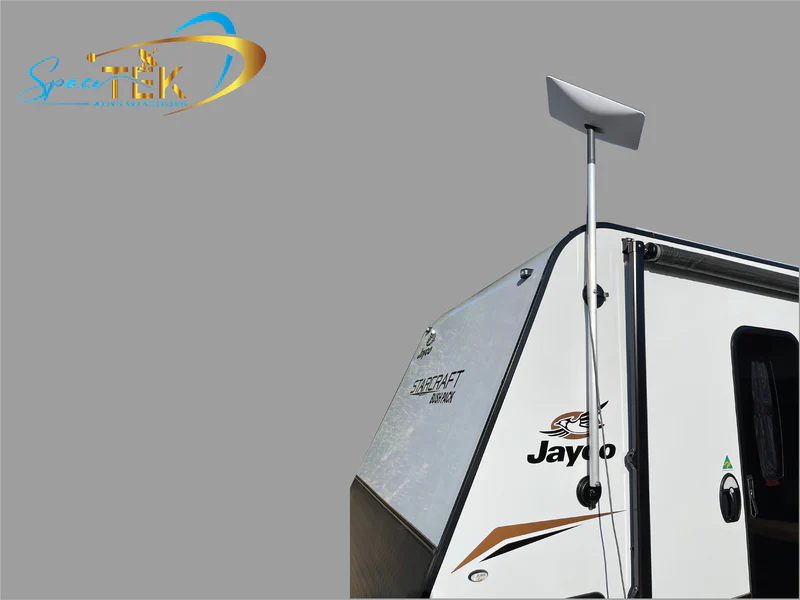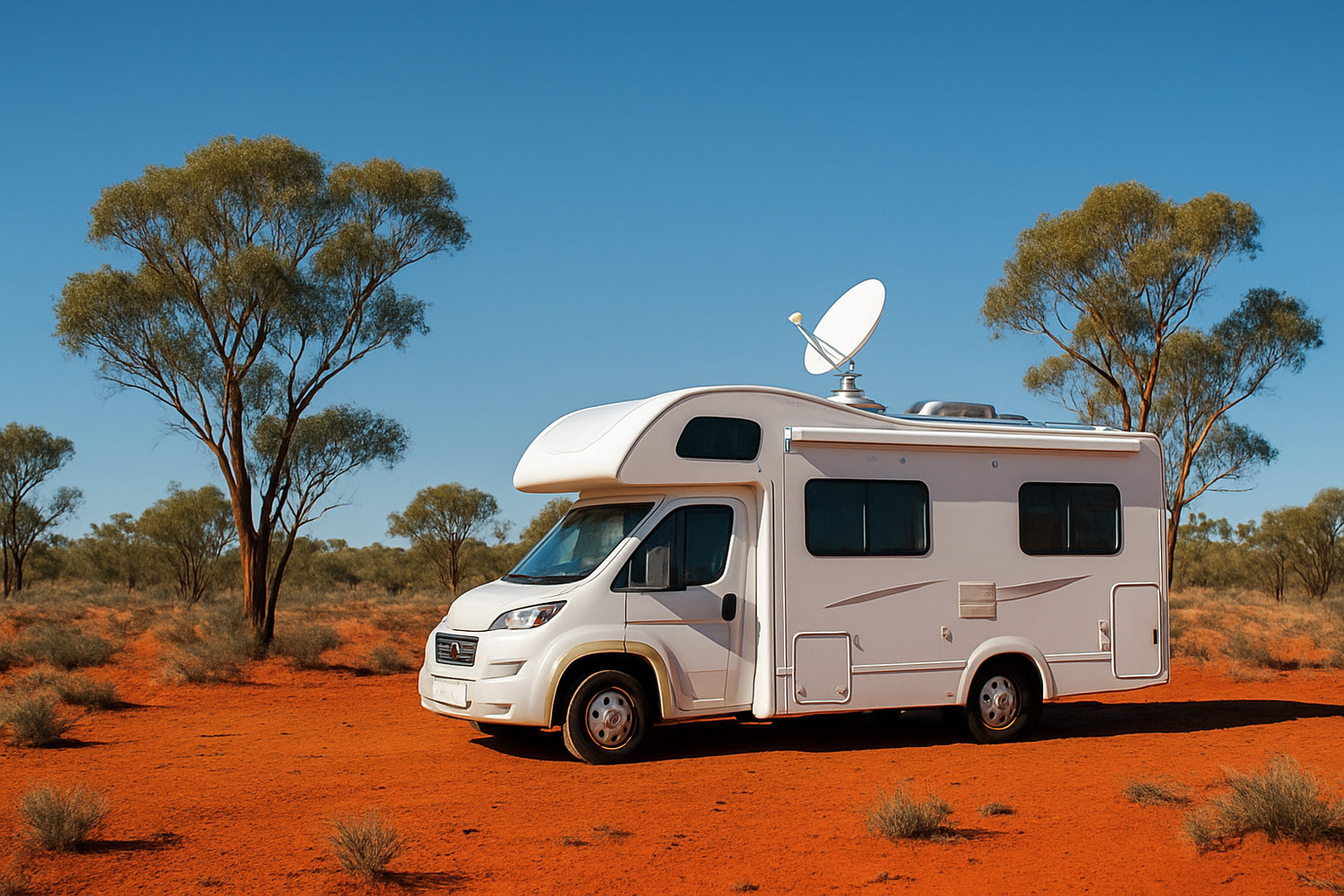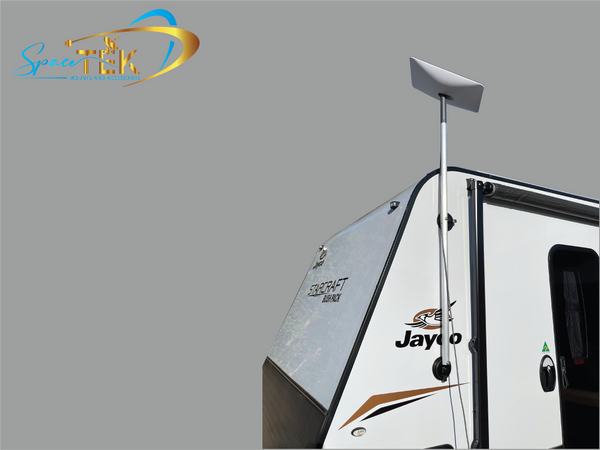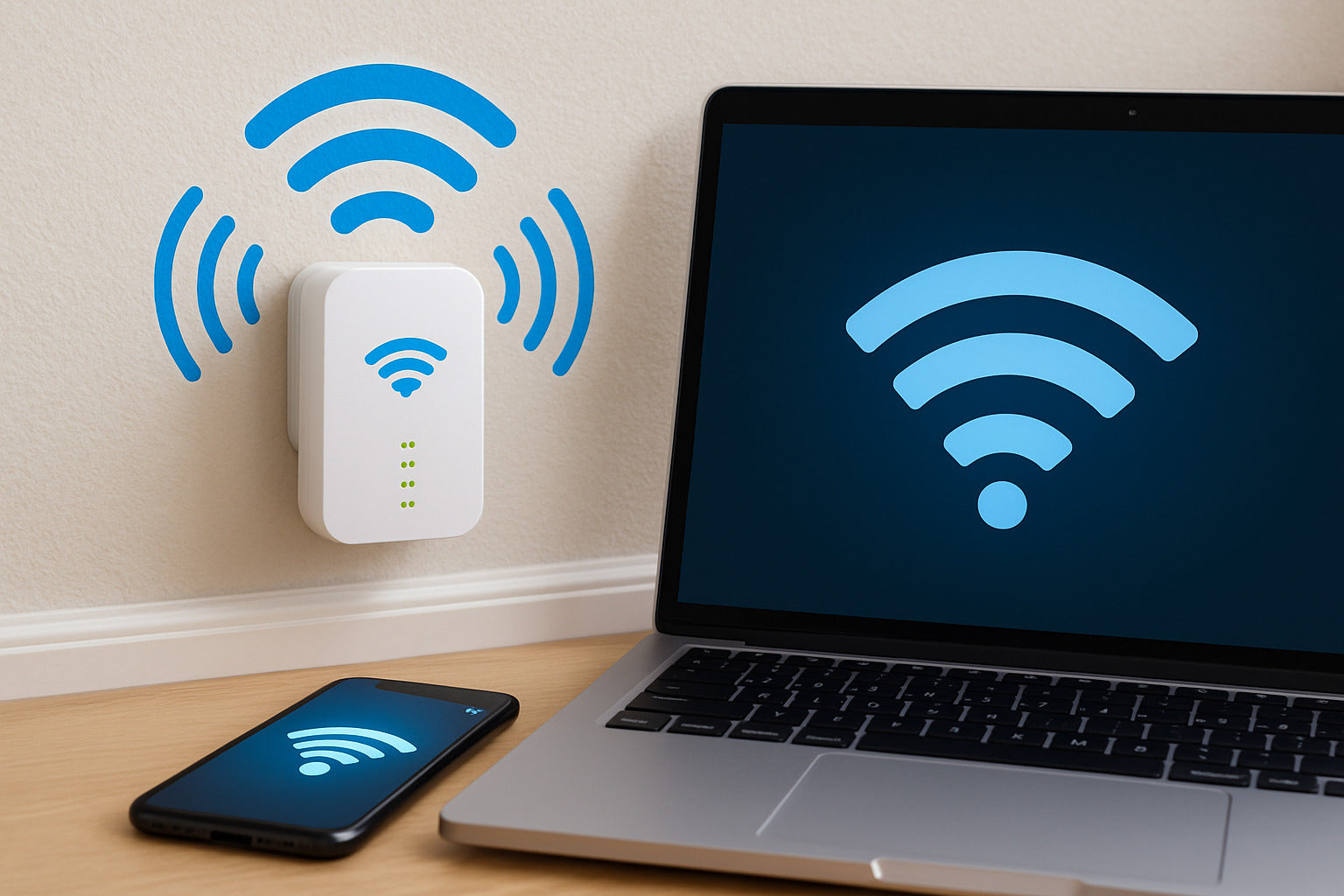Why RV Satellite Internet is Changing Remote Travel in Australia
RV satellite internet australia is reshaping how we explore the outback. From grey nomads in the Kimberley to digital nomads in Cape York, you can now enjoy high-speed internet where mobile towers simply don’t exist.
Quick Answer for RV Satellite Internet in Australia:
- Best Option: Starlink Roam at $599 hardware + $174/month
- Speeds: 100-350 Mbps download in most locations
- Coverage: 90 %+ of Australia with clear sky view
- Power: 50-150 W draw (quality inverter or DC adapter recommended)
- Key Feature: Pause service when you’re not travelling
Low-Earth-orbit (LEO) satellites sit just 550 km above us—65 × closer than traditional geostationary craft—so latency drops to 30-60 ms and streaming from a billabong feels like you’re in the city.
Getting the best from your kit, however, takes more than plugging it in. Smart mounting, sensible power planning and weatherproof accessories turn good connectivity into rock-solid reliability.
I’m Aaron Wroblewski, founder of SpaceTek Australia. After 25+ years connecting remote sites—from HF radios to modern Starlink—I've helped thousands of travellers fine-tune their RV satellite internet Australia setups for our harsh climate.
RV Satellite Internet Australia: How It Works
Picture this: you're camped beside a remote billabong in the Kimberley, watching the sunset paint the sky orange, and you've got internet speeds faster than many city connections. That's the reality of rv satellite internet australia today, and it's all thanks to a shift in how satellite internet works.
Traditional satellite internet relied on massive geostationary satellites parked 35,786 kilometres above Earth. While reliable, the sheer distance meant your data had to travel over 70,000 kilometres just for a simple web page request. The result? Painful delays and sluggish performance that made video calls nearly impossible.
Rv satellite internet australia changed everything by using low Earth orbit satellites positioned just 550 kilometres above us. That's 65 times closer than the old systems, and the difference is remarkable. Your data now zips between your dish and space in 30-60 milliseconds - fast enough for crystal-clear video calls from the most remote corners of Australia.
The system works like a carefully choreographed dance in the sky. Over 4,000 satellites orbit Earth every 90 minutes, and your dish automatically hands off your connection between them as they pass overhead. You never notice the switch - one moment you're connected to a satellite over Queensland, the next it's seamlessly transferred to one approaching from the west.
Twenty ground stations scattered across five Australian states complete the connection. These facilities receive your signal from the satellites and plug you into the global internet backbone. It's this network that delivers approximately 90% uptime, even in challenging coverage areas where mobile towers can't reach.
Scientific research on LEO performance demonstrates the significant advantages of low Earth orbit satellites over traditional geostationary systems, particularly for applications requiring low latency and high throughput.
What is rv satellite internet australia?
Rv satellite internet australia transforms any caravan or motorhome into a mobile office with reliable high-speed internet. The beauty lies in its simplicity - everything arrives in a self-install kit that most people can set up in under an hour.
Your kit includes a sleek satellite dish that looks more like modern art than traditional satellite equipment, a powerful Wi-Fi 6 router, and 30 metres of weatherproof cable. No technician visits, no complex installations - just unbox, position, and connect.
The real game-changer is the Roam plan's flexibility. Unlike fixed residential services, you can use your dish anywhere within Australia's borders. Drive from the Grampians to Kakadu, and your internet follows you. Even better, when you're back in town with reliable mobile coverage, simply pause your subscription through the app. No more paying for months when you're not travelling.
Coverage extends from the tropical beaches of Far North Queensland to Tasmania's rugged highlands. Whether you're exploring the Starlink for Remote Australia network or setting up temporary Starlink for Remote Communities, the system delivers consistent performance across our continent's diverse terrain.
Key Components & Signal Path
The magic of rv satellite internet australia happens through three brilliantly engineered components working in perfect harmony.
Your satellite dish is the star performer, automatically tracking satellites as they streak across the sky at 27,000 kilometres per hour. Built-in GPS and sophisticated sensors maintain optimal positioning without any input from you. The dish operates flawlessly in Australia's harsh conditions, from scorching 50°C desert heat to sub-zero alpine mornings. Its 110-degree field of view means it can communicate with multiple satellites simultaneously, ensuring uninterrupted service.
The Wi-Fi 6 router creates a powerful local network that puts many home systems to shame. Supporting up to 200 connected devices simultaneously, it handles everything from streaming Netflix on multiple screens to running video conferences while the kids game online. Advanced WPA3 security keeps your connection locked down, while mesh networking capabilities let you expand coverage throughout larger RV setups.
The smartphone app serves as your mission control, turning complex satellite internet management into simple taps and swipes. During setup, it guides you through positioning the dish for optimal performance. Once running, it becomes your diagnostic tool - checking for obstructions, running speed tests, and monitoring data usage. The pause feature lives here too, letting you suspend service with a single tap when you're not travelling.
The signal path tells the complete story of how your remote internet connection comes to life. Your device connects to the router via Wi-Fi, which communicates with the dish through the weatherproof cable. The dish beams your request up to the nearest satellite, which relays it to an Australian ground station. From there, it travels through fibre optic networks to reach websites and services worldwide, with the return journey happening in reverse - all in the blink of an eye.

Choosing Hardware & Accessories for Peak Performance
Selecting the right accessories for your rv satellite internet australia setup determines whether you'll enjoy reliable connectivity or face constant frustrations. The standard Starlink kit works well for basic use, but Australian conditions demand upgraded components for optimal performance.
The standard portable dish works perfectly for most RV applications. Its kickstand design allows easy positioning on level ground, and the 30-metre cable provides flexibility for optimal placement. However, the flat high-performance dish at $3,740 offers in-motion capability for those requiring connectivity while driving.
For most travellers, we recommend investing in quality mounting solutions rather than the expensive flat dish. A good roof mount with the standard dish often outperforms the flat option, especially in tree-covered campsites where elevation matters more than aerodynamics.
Best Accessories for rv satellite internet australia
Quality mounts form the foundation of any reliable rv satellite internet australia installation. Our rust-resistant roof mounts withstand Australia's harsh UV, salt air, and temperature extremes while maintaining precise dish alignment.
Suction cup mounts offer incredible versatility for temporary installations. Perfect for testing locations or quick overnight stops, they provide secure mounting on smooth surfaces like caravan roofs or vehicle bonnets. More info about Suction Cup Mount uses.
Mast stands lift your dish above obstacles like awnings or nearby vegetation. Adjustable height options from 1.5 to 3 metres help you find clear sky views in challenging locations. Our heavy-duty construction handles wind loading up to 150 km/h when properly guyed.
Cable management becomes critical in mobile installations. UV-resistant sleeves protect cables from Australia's intense sun, while weatherproof glands seal entry points against dust and moisture. Multi-reel storage systems prevent tangles and damage during travel.
Future-proofing for 2025
The satellite internet landscape continues evolving rapidly. Starlink Mini represents the next generation, offering 50% less power consumption and 75% smaller form factor while maintaining full performance. This compact design suits smaller RVs and reduces mounting complexity.
Gen 3 routers provide improved Wi-Fi 6E performance with tri-band operation and improved range. The upgraded hardware supports faster speeds as satellite capacity increases, ensuring your investment remains current.
Weatherproof cable glands and upgraded connectors handle Australia's extreme conditions better than standard components. Marine-grade materials resist corrosion from salt air near coastlines and maintain reliable connections through temperature cycling.

Setting Up on the Road: Power, Mounting & Portability
Power planning makes or breaks your rv satellite internet australia experience. The dish draws 50-150 W, so pair it with a 300 W pure sine-wave inverter (or a purpose-built DC adapter) and, for off-grid use, at least 400 W of solar feeding a 400 Ah lithium battery bank.
Self-Install Steps
- Use the Starlink app’s obstruction checker to pick a clear southern sky.
- Place the dish on level ground or a secure mount; avoid trip hazards with the 30 m cable.
- Power up the router, follow the in-app wizard, run a speed test and you’re done—often in under 30 minutes.
Document your layout with photos; they’re invaluable when troubleshooting later.
Power & Cable Care
DC-DC converters save roughly 20 % compared with running an inverter full-time. Protect your cable with UV-resistant sleeves and weatherproof glands, and store it on a small reel to prevent kinks during travel.
More info about Cheat Sheet to Accessories
Performance & Troubleshooting in Remote Australia
Dust storms across the Nullarbor can coat dishes and shave 20 % off signal strength; a quick wipe with mild detergent fixes it. The bigger enemy, though, is eucalyptus. A single branch can halve speeds—ground-mounting the dish 5-10 m away often beats a roof mount under trees.
Popular holiday regions see congestion: 200 Mbps in the desert may dip to 60 Mbps when half the east-coast caravans roll into the same spot. Heavy rain causes brief dropouts (usually under 15 minutes), and strong winds demand mounts rated to 120 km/h—exactly what SpaceTek supplies.
Need internet while moving? Under 60 km/h on smooth bitumen it often works, but dropouts are common, so save the work calls for when you’re parked.
Quick Fixes
- Run the obstruction check—moving the dish a few metres often restores full speed.
- Raise it 1-2 m on a mast to clear shrubs or awnings.
- Enable Sleep Mode when offline to save battery.
- Keep your router central and away from metal for stronger in-van Wi-Fi.
Scientific research on obstruction impact
Costs, Plans & Managing Your Service
Getting started with rv satellite internet australia requires a significant upfront investment, but the freedom it provides makes it worthwhile for most travellers. The hardware costs $599 for the standard Starlink kit, plus $30 shipping to most Australian locations. Your monthly service runs $174 for the Roam plan, which allows you to use the system anywhere across Australia.
The flat high-performance dish represents a premium option at $3,740, designed primarily for commercial applications requiring in-motion connectivity. For most RV travellers, this expensive upgrade rarely justifies the cost - especially when proper mounting of the standard dish often delivers superior performance in typical camping situations.
One of the most valuable features for rv satellite internet australia users is the ability to pause service monthly. This flexibility means seasonal travellers can potentially cut their annual costs in half by only paying for months they're actively on the road. The pause and reactivation process takes just seconds through the smartphone app.
Budget Checklist
Beyond the basic hardware cost, you'll need quality accessories for reliable operation in Australian conditions. Budget an additional $300-500 for proper mounting solutions and power management. Quality roof mounts range from $150-400 depending on adjustability and wind rating, while suction cup mounts offer a more affordable $80-150 option for temporary installations.
Power solutions vary dramatically based on your existing setup. Simple DC adapters cost $100-200 and provide more efficient operation than inverters. However, if you need a complete power system upgrade, expect to invest $500-1500 for inverters, additional battery capacity, and charging systems to handle the 50-150W continuous load.
Cable protection might seem like a minor expense at $50-150, but it prevents costly cable replacement down the track. Australian conditions are particularly harsh on exposed cables - UV radiation, temperature cycling, and salt air near coastlines all take their toll. Weatherproof sleeves, entry glands, and protective conduit extend system life significantly.
Dish covers cost $80-150 and protect against debris, hail, and weather damage. While not essential for basic operation, they eliminate frequent cleaning requirements and provide peace of mind during severe weather events common across northern Australia.
Saving Money When Stationary
The pause feature becomes your best friend for managing costs effectively. When you're back in areas with reliable mobile coverage - whether visiting family in the city or staying put for a few months - simply pause your service through the app. This saves $174 monthly and reactivation is equally straightforward when you're ready to hit the road again.
Sharing your connection with neighbouring caravanners creates community while offsetting costs. Most users report speeds consistently above 120 Mbps, providing ample bandwidth for multiple families to share without noticeable performance degradation. This works particularly well at remote locations where everyone benefits from the connectivity.
Resale values remain strong for well-maintained kits, typically holding 60-70% of original value after two years of use. However, transferring service requires cancelling your account and unbinding the hardware - a process that can take several days and may affect availability of new service plans. More info about Starlink RV Pricing covers the complete cost analysis for different usage patterns.
Consider your annual travel patterns carefully when budgeting. Full-time travellers get excellent value from the monthly service cost, while occasional users benefit more from strategic pausing and sharing arrangements with other RV travellers.
Frequently Asked Questions about RV Satellite Internet in Australia
Do I need a clear sky?
Yes—satellites pass low in the southern sky, so anything solid in that arc will block or degrade the signal. The Starlink app’s obstruction checker shows problem spots in seconds.
Can I stay connected while driving?
The standard dish is designed for stationary use. Many travellers see intermittent connectivity on smooth highways, but expect dropouts. If you truly need in-motion internet, consider the flat high-performance dish plus a professional install.
How much power does it use off-grid?
Most travellers see 75-100 W average draw—about 75-100 Ah each day on a 12 V system. Sleep Mode cuts usage to around 15 W when you’re away from camp. A 400 W solar array paired with 400 Ah of lithium comfortably covers multi-day stays.
Starlink Accessories Built for Remote Australia
At SpaceTek Australia, we understand that rv satellite internet australia success depends on quality accessories designed for our unique conditions. Our rust-resistant mounts withstand coastal salt air, outback dust, and temperature extremes that destroy inferior products.
Our mounting solutions range from permanent roof installations to portable options for maximum flexibility. More info about Starlink RV Mounts covers selection criteria for different travel styles.
Cable management systems protect your investment while ensuring reliable performance. UV-resistant materials handle Australia's intense sun, while weatherproof sealing prevents moisture and dust ingress that causes premature failure.
Purpose-built accessories eliminate common problems before they occur. Our dish covers protect against hail damage and debris accumulation, while adjustable mounts allow fine-tuning for optimal signal reception in challenging locations.
More info about Top Tips for Mounting Starlink Mini provides detailed guidance for the latest compact hardware.
Quality accessories pay for themselves through improved reliability and reduced maintenance. Cheap mounts fail when you need connectivity most, while our proven designs deliver years of trouble-free service across Australia's harshest environments.
More info about Stay Online Off-Road accessories covers complete system optimisation for serious remote travellers.

Reliable Internet Starts with the Right Accessories
Rv satellite internet australia means you can now work, stream and stay safe almost anywhere. The secret to consistent performance is simple: match Starlink’s impressive tech with accessories built for Australian conditions.
SpaceTek’s rust-resistant mounts, weatherproof cable management and purpose-built dish covers deliver rock-solid reliability—whether you’re parked beside Uluru or the Daintree.
Ready to upgrade? Explore SpaceTek’s full range of Starlink-compatible accessories and hit the road knowing you’ll stay connected when it matters most.





Leave a comment
This site is protected by hCaptcha and the hCaptcha Privacy Policy and Terms of Service apply.